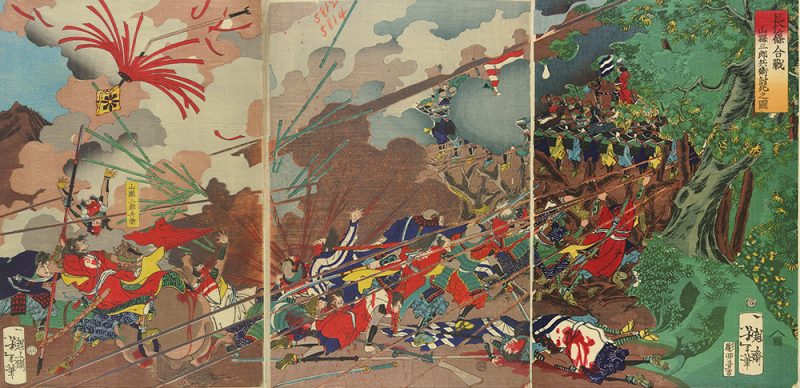From 1400 to 1600, Japan was a fractured country, in endless inner turmoil. The territorial warlords were in constant conflict with each other and there were numerous political issues and civil wars. This period is known as the “Sengoku Jidai” – the Time of Wars. In this fragmented country, the future mighty daimyo, Oda Nobunaga will remain in history as the ruler who will unify Japan and defeat the mighty Ashikaga Shogunate. A brilliant tactician, politician and a capable general, for his might in combat he received the nickname The Demon Daimyo.
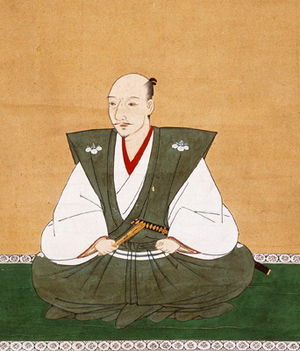
The son of the government official Oda Nobuhide from the Ashikaga Shogunate, Oda Nobunaga, is brought into the world in the Owari province, Honshu. A warlord himself, Oda Nobuhide was in constant war with the rest 7 districts of the Owari province. Upon his father’s death in 1551, only 16 years old, Nobunaga was struggling to remain the head of the Oda clan. His powerful uncle Oda Nobutumo and a younger brother Nobuyuki both wanted to be heads of the Oda clan. In the end, Nobunaga managed to retake leadership over the clan, killing his uncle and later his own brother.
By the end of 1559, he put an end to all the rivalries in the Owari province and eliminated the military struggles inherited from his father. Being the lord of Nagoya Castle, Nobunaga gathered and trained his own military retainers.
Battle of Okehazama
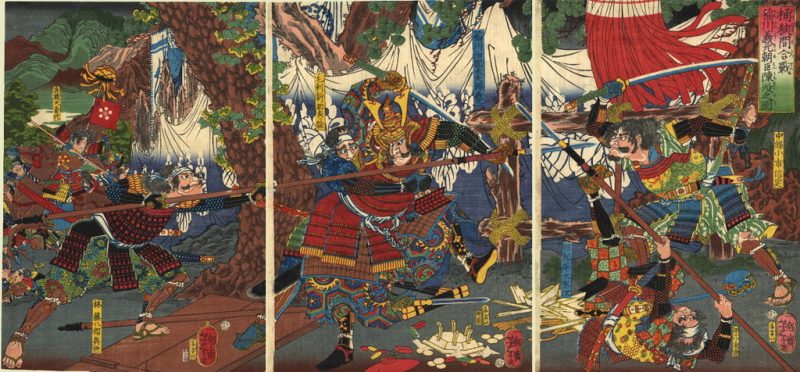
In 1560, the Imagawa, feudal lords of the Suruga province, gathered an army of almost 45,000 men and marched to Owari. Oda Nobunaga commanded a small force of no more than 3,000 samurai.
Heavily outnumbered and against all reason, Nobunaga decided to attack. Near his enemy’s camp, he commanded his men to create an army of dummies and place them in enemy’s line of sight. Leaving these straw samurais behind, he led his men to attack the Imagawa camp from the rare, while the latter were busy counting the army of dummies and calculating their odds against that significantly large force.
After a heavy thunderstorm, which forced the enemy to shelter, Nobunaga’s samurais descended in the narrow gorge where the Imagawa camp was set. The unexpected attack caught all men and their commanders off guard until it was too late. Imagawa himself had no idea what was happening before two samurais attacked him. Although he managed to kill one of them, the second successfully chopped off his head. Left without commanders, the remaining army quickly changed sides and joined Nobunaga.
The Battle of Okehazama ended the rebellion formed against the Oda clan. With this victory, Nobunaga became one of the most powerful daimyos in his period. He also formed several alliances with the Matsudaira, Takeda, and Azai clans. With his superiority in Owari province secured, the castle-town of Nagoya flourished and grew into an important trade center.
The March to Kyoto
Yoshiaki, the brother of the dead thirteenth Ashikaga Shogun, needed revenge for his brother’s murder. He desired to see the new Shogun removed. This new Shogun was a 2-year-old boy, and he was a puppet in the hands of Miyoshi and Matsunaga clans. They used him tp gain political privileges and reigned from behind the scenes.
In 1568, Nobunaga moved his now formidable army towards the Imperial capital of Kyoto and helped Yoshiaki to sit in his rightful place. The Rokkaku clan did not agree with the campaign and opposed the alliance formed between Nobunaga and Yoshiaki. The moment he heard this, the head of the Oda clan launched an attack on the Rokkaku forcing them to flee them from their territory.
The closing of the Oda army influenced the Matsunaga clan, who submitted to the future Shogun. The daimyo Matsunaga Hisahide kept his title by taking this smart decision. Once Nobunaga reached the city of Kyoto, he drove out the Miyoshi clan, who fled to Settsu. Three weeks after these events, Ashikaga Yoshiaki was pronounced the 15th Shogun. Later in 1569, when Nobunaga refused the titles of Kanrei, Yoshiaki realized that he too was but a facade for the daimyo’s true intentions. Hence, he secretly started conspiring with other mighty daimyos to get rid of the Oda clan’s leader.
It was evident that Oda Nobunaga’s ambitions were to make all Japan submit to his will and he used the new Shogun as a justification for his future conquests. He removed the most powerful daimyos away from the capital Kyoto, securing his place as the only one with a big army and powerful influence. Everyone knew he was the one pulling the strings of Shogun Yoshiaki. For Oda to pronounce himself Shogun was pointless. Instead, he built a temple where people were to worship him like a God. Also, he announced that his birthday was to be a national holiday.
Major Battles
Positioning himself in the heart of the country, by the end 1573, he would manage to consolidate his place and build a strong army for his future conquests. Soon his enemies would know Oda Nobunaga was not a fan of the diplomatic approach to any kind of issue. Unlike his contemporaries, he preferred to resolve his problems by force and kept conquering territories.
Battle of Anegawa
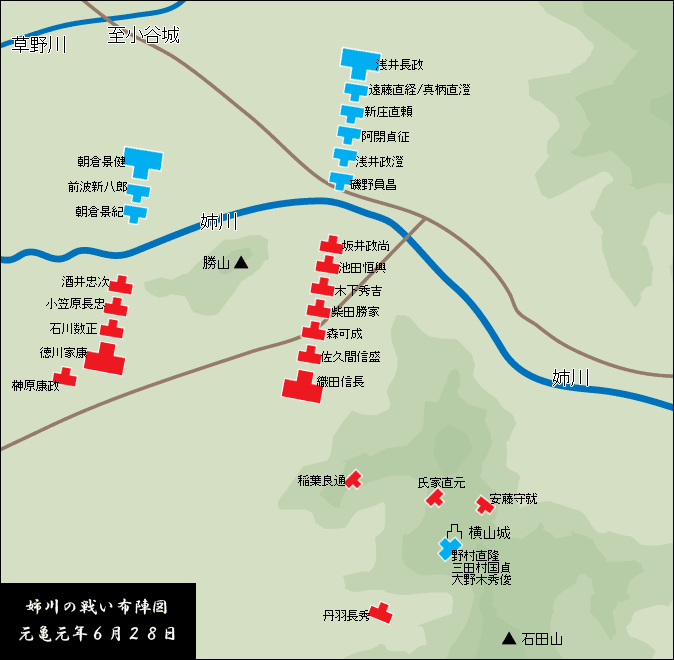
In 1570, an opportunity opened to Nobunaga to eliminate a rival, Asakura Yoshikage. He refused to join a banquet set by the emperor since he was convinced it was Nobunaga who organized it, and this was declared an act of treason. Oda raised an army marched on Echizen.
On the 30th of July, 1570, the anti-Nobunaga alliance of the Asakura and Azai clans faced their enemy with their full combined force. However, Tokugawa Ieyasu united with Oda Nobunaga. The two armies met at the Battle of Anegawa, which led to the decisive victory of the Tokugawa-Nobunaga alliance. The Enryaku-Ji warriors monks who also dared to unite with the anti-Nobunaga force paid heavily for their actions. The entire mountainside of the monastery was painted red with the blood of all its residents, 10,000 people, including women and children. The area was turned into a horrific slaughterhouse, which was to serve as a warning to any who dared to oppose the might of the Oda clan and its leader.
Nobunaga also declared that Buddhists were a danger to his rule and to the stability of Japan and initiated a countrywide hunting and killing of monks; all because they inspired some revolts centuries before.
Siege of Nagashima
Later the blood price was again paid from the Ikko-Ikki resistance, an alliance against the samurai rule. After the Siege of Nagashima and Ishiyama Hongan-ji, that lasted for eleven years, the sight of battle was again a massacre, and all the captured warriors and civilians were killed by Nobunaga’s men.
Battle of Mikatagahara
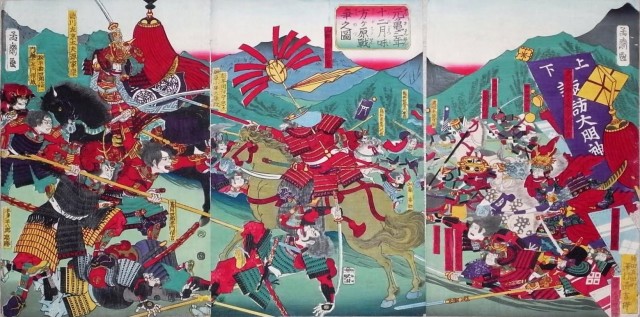
The Shogun Yoshiaki grew restless with Oda Nobunaga, who had increased his power to tremendously, and turned to the Takeda clan. Their leader Takeda Shingen joined the anti-Nobunaga alliance. In 1572, the Kai province daimyo headed to the capital, with intentions to rout the Tokugawa clan on his way. Tokugawa Ieyasu, despite some aid from Nobunaga, suffered a disastrous defeat at the hands of Takeda at the Battle of Mikatagahara. With almost no options left, Nobunaga and Tokugawa bluffed, and convinced Takeda there will be a massive counter-attack. Not long afterward Shingen fell ill and died, and his men withdraw.
In 1573, Nobunaga successfully destroyed the last of the Asakura-Azai alliance. The only enemy left was the Takeda clan with their new lord. Only two years later near Nagashino castle, Nobunaga got the ideal opportunity to destroy this last enemy. Although Yoshiaki kept his title of a Shogun, he was removed from the capital and no longer had any authority.
Battle of Nagashino
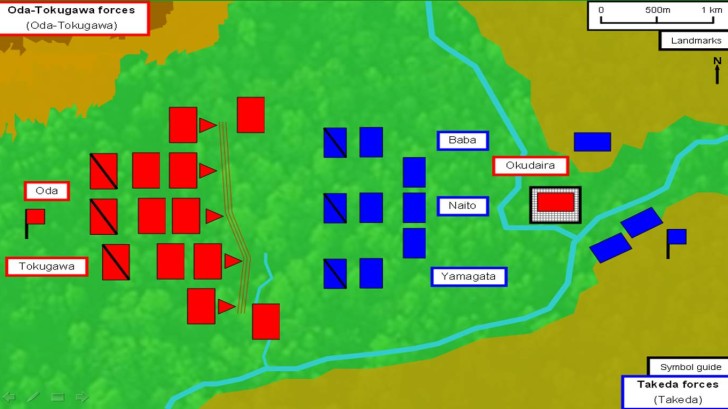
Red(right) -Okudaira
Blue- Takeda
In 1575, Takeda foolishly decided to besiege the castle of one of Tokugawa’s vassals. Both Nobunaga and Tokugawa immediately dispatched troops to break the siege and aid Okudaira Sadamasa, who commanded the castle’s defense. For this battle, the Oda-Tokugawa alliance’s forces greatly outnumbered those of Takeda. They had 25,000 infantry, 10,000 cavalry, and 3,000 arquebusiers while Takeda commanded only a small force of 10,000 infantry and 5,000 cavalry.
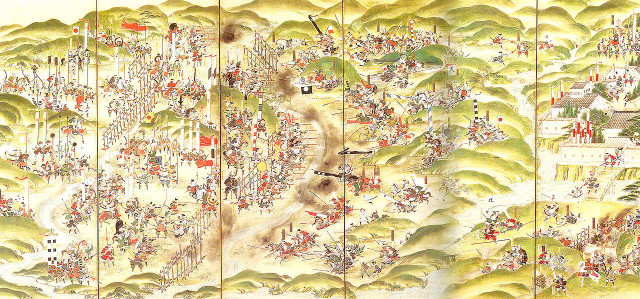
Nobunaga’s usage of arquebusiers greatly contributed to the victory and was a turning point for Japanese warfare. In a matter of hours, Nobunaga’s arquebusier’s volleys had annihilated the charging cavalry of Takeda. Those who survived the shots and reached Nobunaga’s defense line were impaled by the pikemen. By the end of the battle, Takeda had lost 8 of his generals and most of his men. After the battle Nobunaga ordered all the captured enemies and civilians, a total number of around 20,000 people, to be burned alive.
At last after the Siege of Ishiyama Hongan-ji in 1580, he succeeded in completely destroying the Takeda clan.
Coup d’état
Destiny’s ironic approach finally caught up with the ambitious daimyo who liked burning temples. One of his trusty generals, Akechi Mitsuhide, who was supposed to assist his sandal-bearer Hashiba Hideyoshi’s invasion of Bitchu province, initiated a coup d’état. Instead of taking his men to Hideyoshi, Mitsuhide decided to attack Oda Nobunaga, who stayed at the Honnō-ji temple. The Demon Daimyo, Oda Nobunaga died in the burning temple in 1582.
